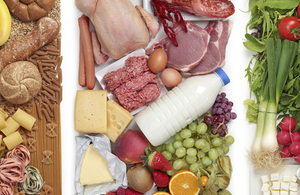Presentation videos: Government Chemist conference 2014
Videos filmed during the 'Beating the cheats: Quality, safety and authenticity in the food chain’ conference at the Royal Society, London.

An image of a selection of food.
Experts outlined how science, regulation and integrity within the food industry can combat food fraud during a 2-day conference in November 2014.
Here is a selection of videos filmed during the event.
Referee case update – lessons from disputes
Michael Walker, Consultant Science Manager, Government Chemist programme
Referee case update – lessons from disputes
Referee casework, the resolution of disputes between regulators and businesses by independent measurement and expert opinion, is a demand-led service at the core of the Government Chemist function. In guaranteeing fair scientific treatment for all by authoritative adjudication on disputes, we underpin public confidence in the food and feed official control system. This presentation outlines the reasons why laboratories’ findings may be rejected.
Proficiency testing: performance verification of the methods used for food safety analysis
Matthew Whetton, Head of Chemistry, Proficiency Testing, LGC
Proficiency testing: performance verification of the methods used for food safety analysis
In response to increasingly sophisticated counterfeiting or food adulteration, a wide range of analytical methodology is being developed and used by concerned organisations and agencies. An important aspect of method development and the on-going operation of analytical methods is verification of their performance by the use of proficiency testing. This presentation explains the ways that proficiency testing contributes to the fight against food fraud.
Wine fraud – catching the cheats
Geoff Taylor, Campden BRI
Wine fraud – catching the cheats
Wine is a massively diverse, complex industry with more than 10,000 different grape varieties grown in a surprisingly wide range of countries and climates. Prices can range from sub £5 to more than £10,000 per bottle, and with such a premium priced commodity product fraud and cheating is inevitable. This presentation how a combination of product knowledge and chemistry is essential in identifying fraud.
Modernising the Public Analyst service
Elizabeth Moran, Association of Public Analysts
Modernising the Public Analyst service
This presentation will reflect on the recommendations in the Elliott review into the integrity and assurance of food supply networks for the future of the public analyst service. It addresses proposals for modernisation of the current services using a case study of a public analyst service.
Light isotope ratio measurements: Applications for food authenticity/origin determination
Phil Dunn, Researcher, LGC
Light isotope ratio measurements: Applications for food authenticity/origin determination
This presentation explains how differences in isotopic composition can be used to discriminate between adulterated and non-adulterated foods, identify whether a product is labelled correctly and establish geographic origin. It also describes the development of a new isotopic ratio reference material.